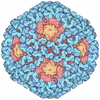+ Open data
Open data
- Basic information
Basic information
| Entry | Database: PDB / ID: 9i70 | ||||||
|---|---|---|---|---|---|---|---|
| Title | 14-3-3sigma binding to the ERa peptide and compound 17 | ||||||
 Components Components |
| ||||||
 Keywords Keywords | PEPTIDE BINDING PROTEIN / 14-3-3 / protein-protein interactions / stabilization | ||||||
| Function / homology |  Function and homology information Function and homology informationregulation of epithelial cell apoptotic process / antral ovarian follicle growth / regulation of branching involved in prostate gland morphogenesis / RUNX1 regulates transcription of genes involved in WNT signaling / RUNX1 regulates estrogen receptor mediated transcription / regulation of toll-like receptor signaling pathway / nuclear estrogen receptor activity / epithelial cell development / steroid hormone receptor signaling pathway / epithelial cell proliferation involved in mammary gland duct elongation ...regulation of epithelial cell apoptotic process / antral ovarian follicle growth / regulation of branching involved in prostate gland morphogenesis / RUNX1 regulates transcription of genes involved in WNT signaling / RUNX1 regulates estrogen receptor mediated transcription / regulation of toll-like receptor signaling pathway / nuclear estrogen receptor activity / epithelial cell development / steroid hormone receptor signaling pathway / epithelial cell proliferation involved in mammary gland duct elongation / prostate epithelial cord elongation / regulation of epidermal cell division / protein kinase C inhibitor activity / prostate epithelial cord arborization involved in prostate glandular acinus morphogenesis / positive regulation of epidermal cell differentiation / keratinocyte development / keratinization / mammary gland branching involved in pregnancy / regulation of cell-cell adhesion / uterus development / negative regulation of smooth muscle cell apoptotic process / vagina development / TFIIB-class transcription factor binding / androgen metabolic process / cAMP/PKA signal transduction / Regulation of localization of FOXO transcription factors / keratinocyte proliferation / mammary gland alveolus development / cellular response to estrogen stimulus / estrogen response element binding / phosphoserine residue binding / Activation of BAD and translocation to mitochondria / negative regulation of keratinocyte proliferation / Mitochondrial unfolded protein response (UPRmt) / establishment of skin barrier / nuclear receptor-mediated steroid hormone signaling pathway / negative regulation of protein localization to plasma membrane / positive regulation of DNA-binding transcription factor activity / negative regulation of DNA-binding transcription factor activity / Chk1/Chk2(Cds1) mediated inactivation of Cyclin B:Cdk1 complex / SARS-CoV-2 targets host intracellular signalling and regulatory pathways / Nuclear signaling by ERBB4 / negative regulation of protein kinase activity / negative regulation of stem cell proliferation / RNA polymerase II preinitiation complex assembly / SARS-CoV-1 targets host intracellular signalling and regulatory pathways / RHO GTPases activate PKNs / positive regulation of nitric-oxide synthase activity / estrogen receptor signaling pathway / positive regulation of protein localization / protein localization to chromatin / steroid binding / 14-3-3 protein binding / TFAP2 (AP-2) family regulates transcription of growth factors and their receptors / negative regulation of canonical NF-kappaB signal transduction / positive regulation of cell adhesion / protein sequestering activity / protein export from nucleus / ESR-mediated signaling / negative regulation of miRNA transcription / negative regulation of innate immune response / TBP-class protein binding / TP53 Regulates Transcription of Genes Involved in G2 Cell Cycle Arrest / release of cytochrome c from mitochondria / positive regulation of protein export from nucleus / nitric-oxide synthase regulator activity / nuclear estrogen receptor binding / transcription corepressor binding / stem cell proliferation / transcription coregulator binding / TP53 Regulates Metabolic Genes / Translocation of SLC2A4 (GLUT4) to the plasma membrane / stem cell differentiation / SUMOylation of intracellular receptors / cellular response to estradiol stimulus / euchromatin / beta-catenin binding / Nuclear Receptor transcription pathway / response to estrogen / transcription coactivator binding / male gonad development / nuclear receptor activity / positive regulation of fibroblast proliferation / intrinsic apoptotic signaling pathway in response to DNA damage / Constitutive Signaling by Aberrant PI3K in Cancer / Regulation of RUNX2 expression and activity / positive regulation of nitric oxide biosynthetic process / sequence-specific double-stranded DNA binding / Ovarian tumor domain proteases / intracellular protein localization / response to estradiol / PIP3 activates AKT signaling / regulation of protein localization / positive regulation of cytosolic calcium ion concentration / ATPase binding / PI5P, PP2A and IER3 Regulate PI3K/AKT Signaling / positive regulation of cell growth / regulation of inflammatory response / DNA-binding transcription activator activity, RNA polymerase II-specific / fibroblast proliferation Similarity search - Function | ||||||
| Biological species |  Homo sapiens (human) Homo sapiens (human) | ||||||
| Method |  X-RAY DIFFRACTION / X-RAY DIFFRACTION /  SYNCHROTRON / SYNCHROTRON /  MOLECULAR REPLACEMENT / Resolution: 1.4 Å MOLECULAR REPLACEMENT / Resolution: 1.4 Å | ||||||
 Authors Authors | Pennings, M.A.M. / Arkin, M.R. | ||||||
| Funding support |  United States, 1items United States, 1items
| ||||||
 Citation Citation |  Journal: Nat Commun / Year: 2025 Journal: Nat Commun / Year: 2025Title: Scaffold-hopping for molecular glues targeting the 14-3-3/ER alpha complex. Authors: Konstantinidou, M. / Zingiridis, M. / Pennings, M.A.M. / Fragkiadakis, M. / Virta, J.M. / Revalde, J.L. / Visser, E.J. / Ottmann, C. / Brunsveld, L. / Neochoritis, C.G. / Arkin, M.R. | ||||||
| History |
|
- Structure visualization
Structure visualization
| Structure viewer | Molecule:  Molmil Molmil Jmol/JSmol Jmol/JSmol |
|---|
- Downloads & links
Downloads & links
- Download
Download
| PDBx/mmCIF format |  9i70.cif.gz 9i70.cif.gz | 129.7 KB | Display |  PDBx/mmCIF format PDBx/mmCIF format |
|---|---|---|---|---|
| PDB format |  pdb9i70.ent.gz pdb9i70.ent.gz | Display |  PDB format PDB format | |
| PDBx/mmJSON format |  9i70.json.gz 9i70.json.gz | Tree view |  PDBx/mmJSON format PDBx/mmJSON format | |
| Others |  Other downloads Other downloads |
-Validation report
| Summary document |  9i70_validation.pdf.gz 9i70_validation.pdf.gz | 763.5 KB | Display |  wwPDB validaton report wwPDB validaton report |
|---|---|---|---|---|
| Full document |  9i70_full_validation.pdf.gz 9i70_full_validation.pdf.gz | 763.9 KB | Display | |
| Data in XML |  9i70_validation.xml.gz 9i70_validation.xml.gz | 16.6 KB | Display | |
| Data in CIF |  9i70_validation.cif.gz 9i70_validation.cif.gz | 24.4 KB | Display | |
| Arichive directory |  https://data.pdbj.org/pub/pdb/validation_reports/i7/9i70 https://data.pdbj.org/pub/pdb/validation_reports/i7/9i70 ftp://data.pdbj.org/pub/pdb/validation_reports/i7/9i70 ftp://data.pdbj.org/pub/pdb/validation_reports/i7/9i70 | HTTPS FTP |
-Related structure data
| Related structure data |  9i6sC  9i6tC  9i6uC  9i6vC  9i6wC  9i6xC  9i6yC  9i6zC  9i71C  9i72C  9i73C  9i74C  9i75C C: citing same article ( |
|---|---|
| Similar structure data | Similarity search - Function & homology  F&H Search F&H Search |
- Links
Links
- Assembly
Assembly
| Deposited unit | 
| ||||||||
|---|---|---|---|---|---|---|---|---|---|
| 1 | 
| ||||||||
| Unit cell |
| ||||||||
| Components on special symmetry positions |
|
- Components
Components
-Protein / Protein/peptide , 2 types, 2 molecules AB
| #1: Protein | Mass: 26542.914 Da / Num. of mol.: 1 Source method: isolated from a genetically manipulated source Source: (gene. exp.)  Homo sapiens (human) / Gene: SFN, HME1 / Production host: Homo sapiens (human) / Gene: SFN, HME1 / Production host:  |
|---|---|
| #2: Protein/peptide | Mass: 613.596 Da / Num. of mol.: 1 / Source method: obtained synthetically / Source: (synth.)  Homo sapiens (human) / References: UniProt: P03372 Homo sapiens (human) / References: UniProt: P03372 |
-Non-polymers , 4 types, 307 molecules 




| #3: Chemical | ChemComp-CA / #4: Chemical | ChemComp-A1I0X / | Mass: 404.892 Da / Num. of mol.: 1 / Source method: obtained synthetically / Formula: C23H21ClN4O / Feature type: SUBJECT OF INVESTIGATION #5: Chemical | ChemComp-CL / | #6: Water | ChemComp-HOH / | |
|---|
-Details
| Has ligand of interest | Y |
|---|---|
| Has protein modification | Y |
-Experimental details
-Experiment
| Experiment | Method:  X-RAY DIFFRACTION / Number of used crystals: 1 X-RAY DIFFRACTION / Number of used crystals: 1 |
|---|
- Sample preparation
Sample preparation
| Crystal | Density Matthews: 2.67 Å3/Da / Density % sol: 53.91 % |
|---|---|
| Crystal grow | Temperature: 277 K / Method: vapor diffusion, sitting drop Details: 0.095 M HEPES pH=7.1-7.7 0.19 M CaCl2 5% glycerol 24-29% PEG400 |
-Data collection
| Diffraction | Mean temperature: 100 K / Serial crystal experiment: N |
|---|---|
| Diffraction source | Source:  SYNCHROTRON / Site: SYNCHROTRON / Site:  ESRF ESRF  / Beamline: ID23-1 / Wavelength: 0.885603 Å / Beamline: ID23-1 / Wavelength: 0.885603 Å |
| Detector | Type: DECTRIS PILATUS 6M / Detector: PIXEL / Date: Oct 11, 2022 |
| Radiation | Protocol: SINGLE WAVELENGTH / Monochromatic (M) / Laue (L): M / Scattering type: x-ray |
| Radiation wavelength | Wavelength: 0.885603 Å / Relative weight: 1 |
| Reflection | Resolution: 1.4→56.31 Å / Num. obs: 55481 / % possible obs: 97 % / Redundancy: 11.3 % / CC1/2: 0.996 / Net I/σ(I): 18.1 |
| Reflection shell | Resolution: 1.4→1.42 Å / Mean I/σ(I) obs: 8 / Num. unique obs: 2777 / CC1/2: 0.961 |
- Processing
Processing
| Software |
| |||||||||||||||||||||||||||||||||||||||||||||||||||||||||||||||||||||||||||||||||||||||||||||||||||||||||
|---|---|---|---|---|---|---|---|---|---|---|---|---|---|---|---|---|---|---|---|---|---|---|---|---|---|---|---|---|---|---|---|---|---|---|---|---|---|---|---|---|---|---|---|---|---|---|---|---|---|---|---|---|---|---|---|---|---|---|---|---|---|---|---|---|---|---|---|---|---|---|---|---|---|---|---|---|---|---|---|---|---|---|---|---|---|---|---|---|---|---|---|---|---|---|---|---|---|---|---|---|---|---|---|---|---|---|
| Refinement | Method to determine structure:  MOLECULAR REPLACEMENT / Resolution: 1.4→56.31 Å / Cor.coef. Fo:Fc: 0.977 / Cor.coef. Fo:Fc free: 0.972 / SU B: 1.274 / SU ML: 0.023 / Cross valid method: THROUGHOUT / ESU R: 0.046 / ESU R Free: 0.044 / Stereochemistry target values: MAXIMUM LIKELIHOOD MOLECULAR REPLACEMENT / Resolution: 1.4→56.31 Å / Cor.coef. Fo:Fc: 0.977 / Cor.coef. Fo:Fc free: 0.972 / SU B: 1.274 / SU ML: 0.023 / Cross valid method: THROUGHOUT / ESU R: 0.046 / ESU R Free: 0.044 / Stereochemistry target values: MAXIMUM LIKELIHOODDetails: HYDROGENS HAVE BEEN USED IF PRESENT IN THE INPUT U VALUES : REFINED INDIVIDUALLY
| |||||||||||||||||||||||||||||||||||||||||||||||||||||||||||||||||||||||||||||||||||||||||||||||||||||||||
| Solvent computation | Ion probe radii: 0.7 Å / Shrinkage radii: 0.7 Å / VDW probe radii: 1.1 Å / Solvent model: MASK | |||||||||||||||||||||||||||||||||||||||||||||||||||||||||||||||||||||||||||||||||||||||||||||||||||||||||
| Displacement parameters | Biso mean: 19.054 Å2
| |||||||||||||||||||||||||||||||||||||||||||||||||||||||||||||||||||||||||||||||||||||||||||||||||||||||||
| Refinement step | Cycle: LAST / Resolution: 1.4→56.31 Å
| |||||||||||||||||||||||||||||||||||||||||||||||||||||||||||||||||||||||||||||||||||||||||||||||||||||||||
| Refine LS restraints |
| |||||||||||||||||||||||||||||||||||||||||||||||||||||||||||||||||||||||||||||||||||||||||||||||||||||||||
| LS refinement shell | Resolution: 1.4→1.436 Å / Total num. of bins used: 20
|
 Movie
Movie Controller
Controller



 PDBj
PDBj

















